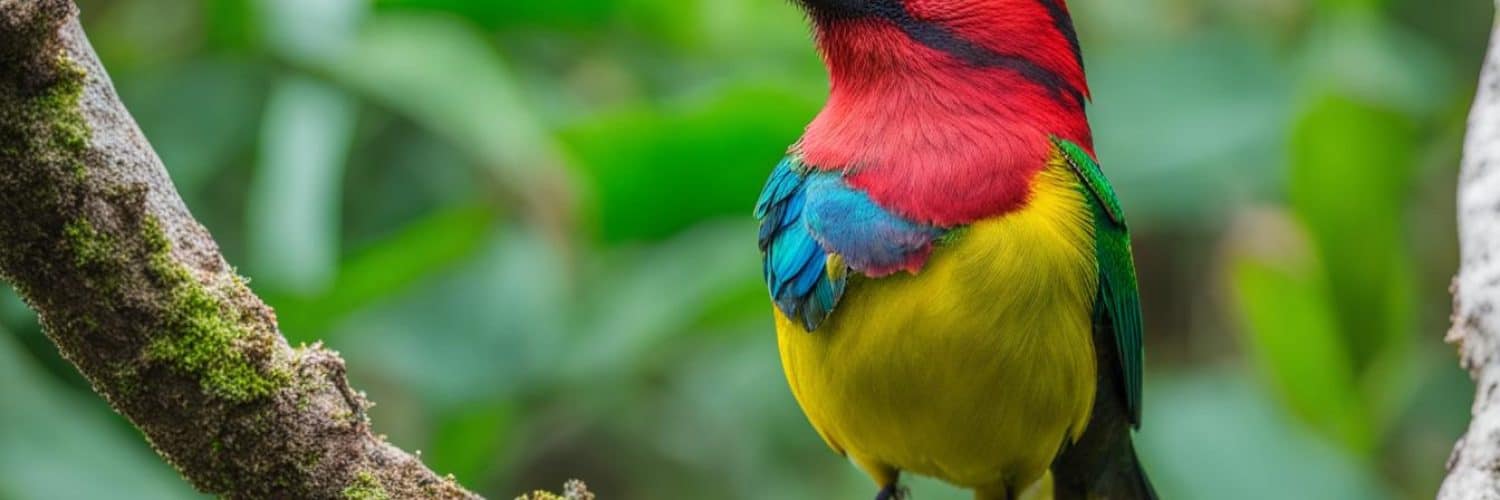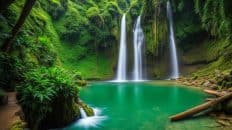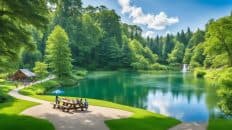Welcome to Biak-na-Bato National Park in Bulacan, Philippines! If you’re a nature enthusiast seeking outdoor adventures, a history buff interested in historical landmarks, or a traveler passionate about ecotourism, this park has something for you. Biak-na-Bato National Park is a protected area known for its breathtaking landscapes, captivating caves, and significant historical background. Embark on a journey of exploration and discover the wonders this conservation area has to offer.
Key Takeaways:
- Biak-na-Bato National Park in Bulacan, Philippines offers a wide range of outdoor activities and cave exploration opportunities.
- The park holds historical significance as the site of the declaration of the first republic in the Philippines, the Republic of Biak-na-Bato.
- Ecotourism is a key focus of the park, with efforts dedicated to conserving its diverse flora, fauna, and the Sierra Madre mountain range.
- Getting to the park is convenient via bus or car, with the nearest towns offering accommodations for visitors.
- When visiting the park, be prepared with entrance fees, guide fees, and follow the park’s rules to ensure a safe and enjoyable experience.
Outdoor Activities in Biak-na-Bato National Park
Biak-na-Bato National Park, located in Bulacan, offers a myriad of outdoor activities for visitors to immerse themselves in the natural beauty of the park. Whether you’re a seasoned adventurer or a beginner seeking a leisurely experience, there’s something for everyone to enjoy.
Hiking
For those who love exploring scenic trails, Mt. Manalmon is the perfect hiking spot. The hike to the summit takes approximately 1 to 2 hours, providing breathtaking views of the park along the way. This trail is ideal for beginners looking for a thrilling outdoor adventure.
Trekking and Swimming
Escape the heat and take a dip in the refreshing waters of the Madlum River. Trekking along the riverbanks allows you to discover hidden gems within the park while enjoying the tranquility of nature. Whether you’re looking to cool off or simply relax, swimming in the Madlum River is a must-do activity.
Picnicking
Biak-na-Bato National Park offers picturesque spots along the riverbanks and open grassy areas that are perfect for picnicking. Gather with friends and family, indulge in delectable food, and soak in the scenic views as you enjoy a memorable picnic amidst the natural surroundings.
Embrace the spirit of adventure and make the most of your time at Biak-na-Bato National Park through an array of outdoor activities. From hiking to swimming and picnicking, this park provides an unforgettable experience for nature enthusiasts and those seeking a peaceful escape.
Cave Exploration in Biak-na-Bato National Park
Biak-na-Bato National Park in Bulacan, Philippines, is a treasure trove of caves waiting to be explored. Among the most notable caves in the park are the famous Madlum Cave and Bayubok Cave.
The renowned Madlum Cave, also known as the Manalmon Cave, holds a prominent place in Filipino pop culture as it served as a filming location for the popular TV series “Mulawin.” This cavernous wonder was also utilized as a refuge during World War II, adding to its historical significance.
For those seeking a more adventurous experience, Bayubok Cave offers an exhilarating spelunking journey. Explorers will navigate through chambers that require crawling, climbing, and rappelling, providing a thrilling challenge at every turn.
Both Madlum Cave and Bayubok Cave offer guided tours led by knowledgeable local guides. These expert companions ensure the safety of visitors and share captivating stories about the caves’ rich history and geological features.
Madlum Cave:
- Location: Biak-na-Bato National Park, Bulacan
- Also known as: Manalmon Cave
- Popular TV series filming location: “Mulawin”
- Used as a refuge during World War II
Bayubok Cave:
- Location: Biak-na-Bato National Park, Bulacan
- Offers challenging spelunking experience
- Requires crawling, climbing, and rappelling
- Expert-guided tours available
| Cave | Main Attractions | Guided Tours | Difficulty Level |
|---|---|---|---|
| Madlum Cave | Scenic chambers, historical significance | Yes | Moderate |
| Bayubok Cave | Challenging passages, thrilling adventure | Yes | Advanced |
Historical Significance of Biak-na-Bato National Park
Biak-na-Bato National Park, located in Bulacan, holds immense historical importance in the rich tapestry of Philippine history. This park witnessed the declaration of the first republic in the country, known as the Republic of Biak-na-Bato. Under the leadership of Filipino revolutionary Emilio Aguinaldo, this momentous event served as a pivotal step towards the eventual attainment of Philippine independence. Within the park, visitors can explore the remnants of stone fortifications and observation outposts that were strategically utilized during the republic. These historical landmarks offer glimpses into the arduous struggle for independence and serve as a reminder of the courage and determination of the Filipino people.
“The history of Biak-na-Bato National Park embodies the resilience and unwavering spirit of the Filipino people in their pursuit of freedom and sovereignty.” – Emilio Aguinaldo
Key Historical Features in Biak-na-Bato National Park
The park showcases significant features from the era of the Biak-na-Bato Republic, shedding light on the brave individuals who played pivotal roles in shaping the country’s destiny. Some notable historical highlights within the park include:
- The ruins of stone fortifications built to defend the republic
- Observation outposts that once offered strategic advantages
- The location where the historic declaration of the Republic of Biak-na-Bato was made
Exploring these sites provides an opportunity to immerse oneself in the rich history and gain a deeper understanding of the struggles and triumphs that paved the way for Philippine independence.
Emilio Aguinaldo’s Contribution
Emilio Aguinaldo, a revered Filipino leader and key figure in Philippine history, played a crucial role in the establishment of the Republic of Biak-na-Bato. His leadership and unwavering commitment to the cause of independence inspired countless individuals to join the revolution. Aguinaldo’s determination, vision, and strategic actions continue to be celebrated as pivotal elements in the fight for Philippine sovereignty.
Historical Landmarks in Biak-na-Bato National Park
| Landmark | Description |
|---|---|
| Ruins of Stone Fortifications | Remnants of the defensive structures that protected the Republic of Biak-na-Bato |
| Observation Outposts | Overlook points strategically positioned for monitoring and defense |
| Declaration Site | Location where the historic declaration of the Republic of Biak-na-Bato was made |
Ecotourism in Biak-na-Bato National Park
Biak-na-Bato National Park in Bulacan, Philippines, stands as a shining example of ecotourism at its finest. The park is committed to the preservation and protection of its natural resources, making it a conservation area of utmost importance. Visitors to the park have the opportunity to witness the breathtaking variety of flora and fauna that call this area home.
Biak-na-Bato National Park boasts a diverse range of plant species, including vibrant orchids, towering trees, lush shrubs, graceful ferns, and colorful bushes. This rich assortment of flora creates a vibrant tapestry of colors, textures, and scents that captivate the senses and provide a haven for countless species of birds and animals.
“Biak-na-Bato National Park is a treasure trove of natural wonders, showcasing the harmonious relationship between the plant and animal kingdoms. It is a sanctuary for both indigenous and migratory bird species, adding to its allure as an ecotourism destination.” – Local Naturalist
The park’s conservation efforts extend beyond its boundaries, as it is located within the Sierra Madre mountain range. This mountain range is renowned worldwide for its incredible biodiversity and ecological significance. Nestled in this magnificent landscape, Biak-na-Bato National Park plays a vital role in protecting the delicate balance of nature within its borders and contributing to the overall ecological integrity of the Sierra Madre mountain range.
Embarking on an ecotourism adventure in Biak-na-Bato National Park allows visitors to immerse themselves in the wonders of nature while contributing to its conservation. Whether marveling at the beauty of the park’s flora, observing the diverse bird species, or simply taking in the awe-inspiring views of the Sierra Madre mountain range, each visitor becomes an active participant in the ongoing efforts to safeguard this precious ecosystem.
| Flora | Fauna |
|---|---|
| Orchids | Indigenous Bird Species |
| Trees | Migratory Bird Species |
| Shrubs | Small Mammals |
| Ferns | Reptiles |
| Bushes | Insects |
Accessibility to Biak-na-Bato National Park
Biak-na-Bato National Park is easily accessible from Manila. Whether you prefer traveling by bus or car, reaching the park is a convenient journey.
By Bus
If you’re traveling by bus, you can take a bus to Cabanatuan City or Gapan City that passes by San Miguel, Bulacan. From there, you can easily reach Biak-na-Bato National Park by hopping on a tricycle.
By Car
For those traveling by car, you can take the North Luzon Expressway and exit at Sta. Rita. Proceed to the Plaridel Bypass Road and continue your journey to San Miguel. Once you’ve arrived in San Miguel, simply ask the locals for directions to Brgy. Madlum, where the park is located.
With these convenient transportation options, you can easily embark on your adventure to Biak-na-Bato National Park and immerse yourself in its breathtaking natural beauty.
“Biak-na-Bato National Park offers easy accessibility, making it an ideal destination for nature enthusiasts from Manila and beyond.” – Travel Journal
| Transportation Method | Route | Directions |
|---|---|---|
| Bus | Manila to San Miguel, Bulacan | Bus to Cabanatuan City or Gapan City, then tricycle to Biak-na-Bato National Park |
| Car | Manila to San Miguel, Bulacan | North Luzon Expressway, Sta. Rita Exit, Plaridel Bypass Road, San Miguel, then ask locals for directions to Brgy. Madlum |
Expenses and Tips for Visiting Biak-na-Bato National Park
When planning a visit to Biak-na-Bato National Park, it’s essential to be aware of the expenses and take note of some helpful tips to make the most out of your trip. Here are the key details you need to know:
Entrance Fees
To enter Biak-na-Bato National Park, there is an entrance fee of PHP 30 per person. This fee is necessary for the maintenance and preservation of the park’s natural beauty and historical landmarks.
Guide Fees
If you’re interested in exploring the caves within the park, it is highly recommended to hire a local guide. The guide fee is PHP 300 per group of 10 persons, ensuring a safe and informative experience as you navigate through the fascinating underground wonders of Biak-na-Bato National Park.
Caving Fees
While exploring the caves, additional caving fees may apply. The fees vary depending on the specific cave you choose to explore. These fees contribute to the upkeep and conservation efforts of the cave ecosystems, ensuring their preservation for future generations.
Tips for a Memorable Visit
- Bring extra clothes: If you plan on swimming in the river or exploring the caves, it’s recommended to bring spare clothes to enjoy your outdoor adventures to the fullest.
- Prepare your own food and drinks: Biak-na-Bato National Park has limited dining options, so it’s a good idea to bring your own snacks and drinks to keep you energized throughout your visit.
- Follow park rules and regulations: To maintain the park’s pristine condition and preserve its natural surroundings, it’s important to adhere to the rules and regulations set by the park management. This includes refraining from littering, respecting wildlife, and refraining from damaging any historical landmarks.
Visiting Biak-na-Bato National Park is a unique and enriching experience. By being prepared with knowledge about the expenses and following a few helpful tips, you can fully enjoy all that this incredible park has to offer while contributing to its conservation and sustainability.
Nearby Attractions and Accommodations
Biak-na-Bato National Park is surrounded by a variety of exciting attractions and offers convenient access to accommodations for visitors to enjoy.
Mount Gola
Just a short hike from Biak-na-Bato National Park, Mount Gola presents additional opportunities for outdoor enthusiasts. With its scenic trails and breathtaking views, this mountain is ideal for hiking and trekking adventures. Take your time to explore the natural beauty of the area and immerse yourself in the peaceful ambiance of the surroundings.
Mariveles
If you’re looking to further enhance your exploration of the region, a visit to Mariveles is highly recommended. This nearby town boasts stunning beaches and fascinating historical sites. Enjoy some sun and sand or delve into the town’s rich heritage by exploring its historical landmarks. Mariveles offers a delightful mix of natural beauty and cultural experiences, creating a well-rounded destination for travelers.
Accommodations
When it comes to accommodations, several hotels and resorts are available in nearby towns such as San Miguel and Plaridel. These establishments offer comfortable rooms and amenities to ensure a pleasant stay for visitors. Whether you’re seeking a luxurious resort experience or a budget-friendly option, you’ll find a range of choices that suit your preferences and budget.
In Summary
Biak-na-Bato National Park not only provides an exceptional outdoor experience but also offers easy access to nearby attractions and comfortable accommodations. Explore Mount Gola’s captivating trails and take in the stunning scenery, or visit the charming town of Mariveles for its beautiful beaches and historical sites. With various accommodations available, you can find the perfect place to relax and recharge after your adventures in and around Biak-na-Bato National Park.
Conclusion
Biak-na-Bato National Park in Bulacan, Philippines, is a hidden gem that offers a perfect blend of natural beauty and historical significance. This park is a paradise for outdoor enthusiasts, as it boasts stunning caves, picturesque landscapes, and various exciting activities.
For those who love hiking and trekking, Mt. Manalmon awaits you with its breathtaking views and invigorating trails. If you’re an adventure seeker, exploring the magnificent Madlum Cave and Bayubok Cave will give you an adrenaline rush like no other.
But Biak-na-Bato National Park is not just about outdoor adventures. It holds a significant place in Philippine history as the birthplace of the Republic of Biak-na-Bato. Discover the remnants of stone fortifications and observation outposts that played a substantial role in the country’s fight for independence.
Whether you’re a nature lover, history enthusiast, or someone seeking thrilling exploits, Biak-na-Bato National Park offers an unforgettable experience that you won’t find anywhere else. Plan your visit and immerse yourself in the beauty and wonders of this conservation area.
FAQ
What is Biak-na-Bato National Park?
Biak-na-Bato National Park is a protected area located in Barangay Biak-na-Bato in San Miguel, Bulacan. It was declared a national park in 1937 and covers a total area of 2,117 hectares. The park is known for its caves, outdoor activities, and historical significance.
What are the outdoor activities available in Biak-na-Bato National Park?
In Biak-na-Bato National Park, visitors can enjoy activities such as hiking, trekking, swimming, and picnicking. The park offers beautiful hiking trails, a river for swimming, and scenic spots for picnics.
What caves can be explored in Biak-na-Bato National Park?
The park is home to famous caves such as Madlum Cave and Bayubok Cave. Madlum Cave, also known as the Manalmon Cave, is a filming location and served as a refuge during World War II. Bayubok Cave offers a challenging spelunking experience.
What is the historical significance of Biak-na-Bato National Park?
Biak-na-Bato National Park is the site of the declaration of the first republic in the Philippines, the Republic of Biak-na-Bato. It played a significant role in the country’s struggle for independence. The park also has ruins of stone fortifications and observation outposts used during the republic.
What is ecotourism in Biak-na-Bato National Park?
Biak-na-Bato National Park is a conservation area dedicated to preserving its natural resources. It is home to diverse plant and animal species, promoting biodiversity. The park is located in the Sierra Madre mountain range, known for its rich flora and fauna.
How can I get to Biak-na-Bato National Park?
To get to Biak-na-Bato National Park, you can take a bus to Cabanatuan City or Gapan City that passes by San Miguel, Bulacan. From there, you can take a tricycle to the park. If you’re traveling by car, you can follow the North Luzon Expressway and take the Sta. Rita Exit, then continue to Plaridel Bypass Road to San Miguel.
What are the expenses and tips for visiting Biak-na-Bato National Park?
When visiting the park, you should be prepared to pay entrance fees, guide fees, and caving fees. The entrance fee is PHP 30 per person, while the guide fee is PHP 300 for a group of 10 persons. Caving fees vary. It is recommended to bring extra clothes, food, and drinks. Follow the park’s rules and regulations and respect the natural surroundings.
What nearby attractions and accommodations are available near Biak-na-Bato National Park?
Nearby attractions include Mt. Gola, another mountain ideal for hiking and trekking, and Mariveles, a town known for its beaches and historical sites. Accommodations like hotels and resorts can be found in nearby towns such as San Miguel and Plaridel.
What makes Biak-na-Bato National Park worth visiting?
Biak-na-Bato National Park offers a unique and immersive experience for outdoor enthusiasts, history buffs, and nature lovers. From cave exploration and outdoor activities to historical landmarks and conservation efforts, the park provides a haven for adventure and exploration.


















Add comment